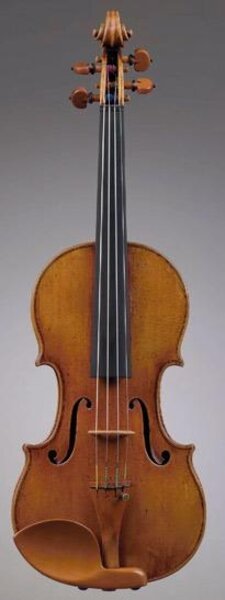Fiddling with Stradivari's formulas
Loading...
OK. So cold weather forced Yitzhak Perlman, Yo-Yo Ma, & Co. to "finger sync" the music the quartet played at President Barack Obama's Inauguration.
Still, you can't knock the sound. Both artists boast instruments built by Antonio Stradivari. And Joseph Nagyvary says he may have unlocked one of the famed luthier's secrets.
A team of scientists Dr. Nagyvary leads reports that it's found chemicals bound up in the wood the instrument makers used. The chemicals are absent from natural samples. Among the compounds: borax, iron-based salts, a dash of chromium, and some flourides.
The researchers suggest that the fabled 16th- and 17th-Century craftsmen of Cremona, Italy, impregnated the wood with these compounds to fend off wood worms -- a problem Nagyvary says was rampant at the time.
Enter the law of unintended consequences. These preservatives in effect reduce the density of the wood. In doing so, the team suggests, the treatment helped give the luthiers' instruments the ability to deliver their unique tones.
Nagyvary is a biochemist at Texas A&M University. Over the years, he's focused his research on the molecular building blocks of DNA and RNA, building blocks known as nucleotides. He's been involved in work on the origin of life, as well as on the effects of dietary fiber. But in 1983, he set his sights on unraveling the secrets of the fabled craftsmen of Cremona, Italy.
It's a quest with a rich tradition. In the April 10, 1908, issue of the journal Science, for example, one Frank Della Torre of Baltimore, Md., writes: "The writer, after a great deal of experimenting...has found a gum varnish which he believes is identical with that used by the Cremona makers." The varnish, he posits, "damps out the upper harmonics, leaving the pure fundamental tone to be heard."
Well, maybe. Maybe not. Forty-eight years later, a researcher at a chemical company in Cincinnati offered in the pages of the same journal that "metal rosinates" in the varnishes held the key.
Researchers also have focused on the qualities of the wood itself. It was taken from trees that grew during the Little Ice Age -- a period when trees grew more slowly, leaving them with wood that was more dense than it otherwise would have been.
Last year, researchers in the Netherlands and the US used x-rays to study the wood in the original Cremona instruments. They found that the average density of grains in modern wood samples and in the famed instruments was the same. But the grains in the instruments' wood showed far less variation in density between the early and mature growth stages than did the modern samples.
The team suggests this would have made a difference in the wood's stiffness, and hence the sound of the finished product.
For its work, Nagyvary's team coaxed some violin restorers to part with shavings they'd gathered as they made repairs to several instruments from Cremona's heyday: a violin and cello by Stradivari and two violins by Guarneri. They also used samples from French- and British-made antique instruments. They compared all of the older instruments to each other and to modern commercial woods.
To tease out the chemicals, they heated the samples until they turned to ash, then analyzed what was left. The four Cremona instruments showed clear signs of treatment, although the mix of chemicals varied from instrument to instrument.
The work has its limits, the team acknowledges. For instance, all of the shavings came from maple backs of the instruments. The team had no access to spruce shavings. One goal would be to test for similar chemicals in the spruce the luthiers used.
So what's a modern-day Stradivari wanna-be to do? Got your varnish? Check. Your wood with uniform density through its growing cycle? Check. If these results -- published on Jan. 22 in the online journal Public Library of Science One -- are any indication, add another step. Try soaking those planks in a solution that includes a strong dash of 20 Mule Team Borax. Ronald Reagan would have approved.






